Services on Demand
Journal
Article
Indicators
-
 Cited by SciELO
Cited by SciELO -
 Access statistics
Access statistics
Related links
-
 Similars in
SciELO
Similars in
SciELO  uBio
uBio
Share
Revista Boliviana de Química
On-line version ISSN 0250-5460
Rev. Bol. Quim vol.23 no.1 La Paz 2006
ARTÍCULO ORIGINAL
SECONDARY METABOLITES FROM CAESALPINIA PLUVIOSA
Yonny Flores, Jose Vila, Giovanna R. Almanza*
Laboratorio de Productos Naturales, Instituto de Investigaciones Químicas, Carrera de Ciencias Químicas, Universidad Mayor de San Andrés, Campus Universitario de Cota Cota c. 27, C. P. 303 La Paz, Bolivia
*Autor corresponsal: giovyalmanza@yahoo.com.ar
ABSTRACT
Two phenolic compounds, ethyl gallate and rhuschalcone VI, together with lupeol, betulinic acid and stigmasterol were isolated from the stem bark of Caesalpinia pluviosa D.C. Their structures were determined by spectroscopic means mainly by NMR experiments, completing all the NMR assignments of phenolic compounds.
In addition, the extracts and pure compounds were evaluated against the bacteria Staphylococcus aureus, HPIA test and the antimalarial in vitro assay against Plasmodium falciparum, determining that CH2Cl2 extract and rhuschalcone VI showed good activity in the antibacterial and HPIA tests.
Key words: Caesalpinia pluviosa, rhuschalcone VI, ethyl gallate, triterpenes, antibacterial, antimalarial.
RESUMEN
Dos compuestos fenólicos, galato de etilo y rhuschalcona VI, junto con lupeol, ácido betulínico y estigmasterol fueron aislados de la corteza de Caesalpinia pluviosa DC. Sus estructuras fueron determinadas por medios espectroscópicos, completando todos los asignamientos de RMN de los compuestos fenólicos.
Además, los extractos y compuestos puros fueron evaluados contra la bacteria Staphylococcus aureus, la prueba HPIA y el ensayo antimalarico in vitro contra Plasmodium falciparum determinando que el extracto CH2Cl2 y rhuschalcone VI muestran buena actividad en las pruebas antibacterianas y HPIA.
Palabras claves: Caesalpinia pluviosa, rhuschalcona VI, galato de etilo, triterpenos, antibacteriano, antimalárico
INTRODUCTION
Caesalpiniaceae is a large family distributed throughout Bolivia; it includes 26 genus with approximately 76 species [1]. Caesalpinia pluviosa D.C. is a tree that can grow until 20 meters tall, that is found in the Amazonian part of Bolivia. The decoction of its stem bark is used in the Bolivian folk medicine as a remedy for diarrhea [2]. According to literature, several Caesalpinia species have been studied phytochemically and pharmacologically, yielding cassane type diterpenes [3],[4],[5],[6] flavonoids [7],[8], biflavonoids [9] and tannins.[10]
In this paper, we report the isolation and structural elucidation of two phenolic compounds, ethyl gallate (1) and rhuschalcone VI (2) from the stem bark of C. pluviosa, completing all their NMR assignments. In addition, we determine the presence of three triterpenic compounds: lupeol (3), betulinic acid (4) and stigmasterol (5), metabolites widely distributed in the Plant Kingdom. Finally, continuing the research of antibacterial and antimalarial natural products from Bolivian Plants, the extracts and pure compounds were evaluated against Staphylococcus aureus, Plasmodium falciparum and HPIA test.
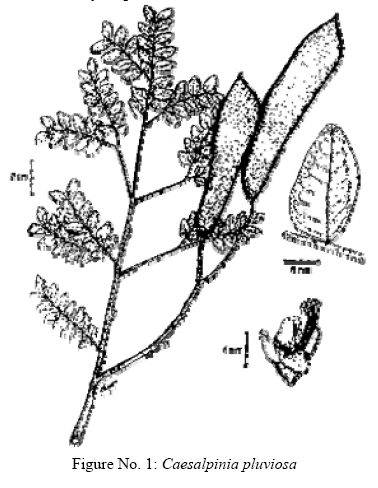
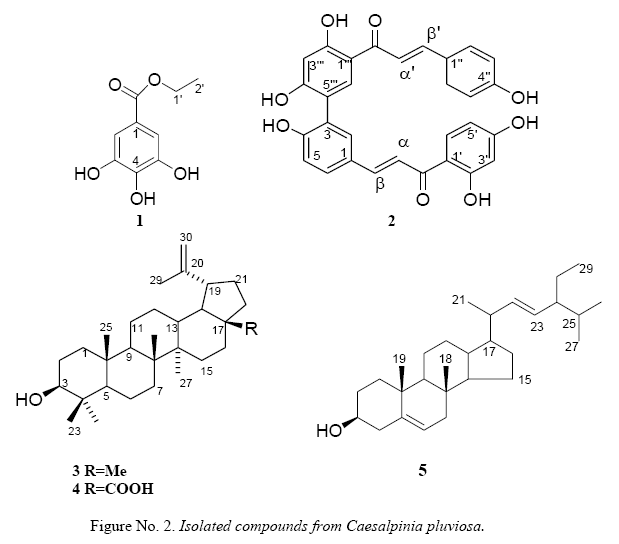
RESULTS AND DISCUSSION
1.67 kg of milled dried stem bark of C. pluviosa was extracted successively with petroleum ether and ethanol. The concentrated EtOH extract was further extracted with CH2Cl2: MeOH (9:1). Ethyl gallate (1) and rhuschalcone VI (2) were isolated from the CH2Cl2:MeOH fraction following diverse chromatographic techniques for instance flash chromatography, preparative chromatography and gel filtration. Lupeol (3), betulinic acid (4) and stigmasterol (5), were isolated from the petroleum ether extract. The structures of all compounds were established by spectroscopic means. For the triterpenoids and sterol the spectroscopic data were compared with those reported in the literature.
Compound (1) was isolated as a white amorphous powder, and the molecular formula C9H10O5 was assigned by MS (m/z 199.1337, [M+H]+; calc. 199.0606) which is in agreement with the 1D NMR data. The 13C NMR spectrum (Table No. 1) exhibited 9 signals: one carbonyl, two aliphatic carbons and 6 aromatic carbons, three of them between 135 and 145 ppm suggesting a phenolic derivative. The 1H NMR spectrum showed one aromatic signal at 7.03 ppm (2H, s) which suggest an aromatic system tetrasubstituted, two aliphatic protons at 4.26 ppm (2 H, q, 11.1 Hz) from a methylene group and at 1.33 ppm one aliphatic methyl group (3H, t, 11.1 Hz), both groups have correlation each other (Table No. 1). Based on this data we suggested the structure of (4) which was confirmed by 2D NMR experiments. The HMBC experiment showed, among others, the correlation of the proton at 7.03 ppm with the aromatic carbons at 121.0 ppm, 144.4 ppm 137.4 ppm and with THE carboxyl carbon at 167.3 ppm. In addition, the correlation of the proton at 4.26 ppm with the carboxyl carbon joins the aliphatic system with the aromatic part, confirming that the molecule is ethyl gallate.
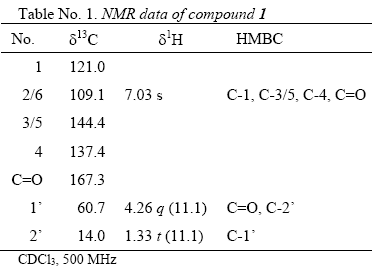
Compound (2) was isolated as a yellow powder, the HREIMS showed a molecular ion at m/z 511.1342 [M-H+]; calc. for 511.1387 which was consistent with the molecular formula C30H22O10. The 13C NMR spectrum exhibited 30 signals: two carbonyls, and 28 olefinic and aromatic carbons, suggesting a biflavonoid structure [11]. The 1H NMR spectrum together with the 1H-1H COSY experiment allowed the identification of two set of trans-alkenes [δ 7.83 (1H, d, 15.5 Hz) and 7.62 (1H, d, 15.5 Hz)] and [δ 7.78 (1H, d, 15.7 Hz) and 7.58 (1H, d, 15.7 Hz)], one 4-oxyphenyl groups [δ 7.56 (2H, d, 8.7 Hz), 6.78 (2H, d, 8.7 Hz)]; one 2,4-dioxyphenyl group [δ 7.94 (1H, d, 9.0 Hz), 6.37 (1H, dd, 9.0, 2.4 Hz.), 6.27 (1H, d, 2.4 Hz)]; one tri-substituted aromatic rings [δ 6.94 (1H, d, 8.5 Hz), 7.60 (1H, dd, 8.5, 2.1 Hz), 7.67 (1H, d, 2.1 Hz)]; and one tetra-substituted aromatic ring [δ 7.95 (1H, s), 6.41 (1H, s)], the 1H and 13C NMR spectra are showed in Figure 3. Full assignments of the proton and carbon NMR signals were made by use of HMQC and HMBC spectra to confirm the structure as rhuschalcone VI, previously reported by Mdee et al. [12], Some HMBC correlation are showed in the Figure 3.
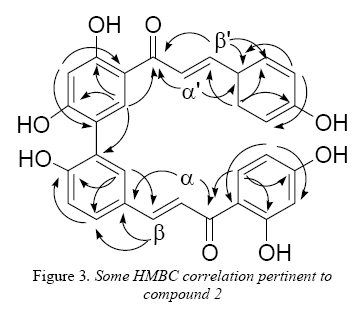

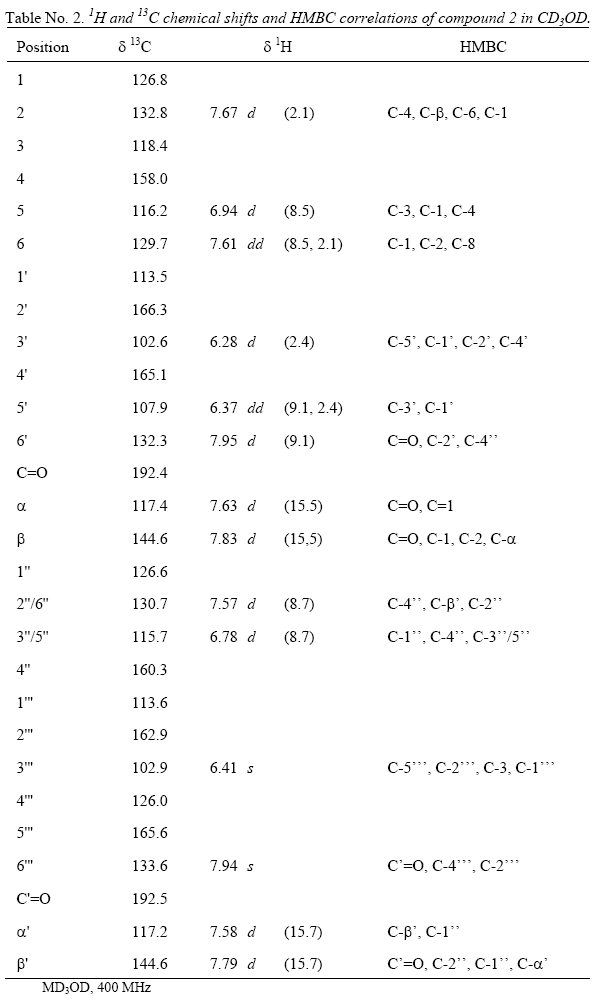
The comparison of physical and spectroscopic data for (3), (4), and (5) with those from literature made possible their identification as lupeol, betulinic acid and stigmasterol. Table No. 3 shows the comparison of the 13 C NMR data with those of the literature.
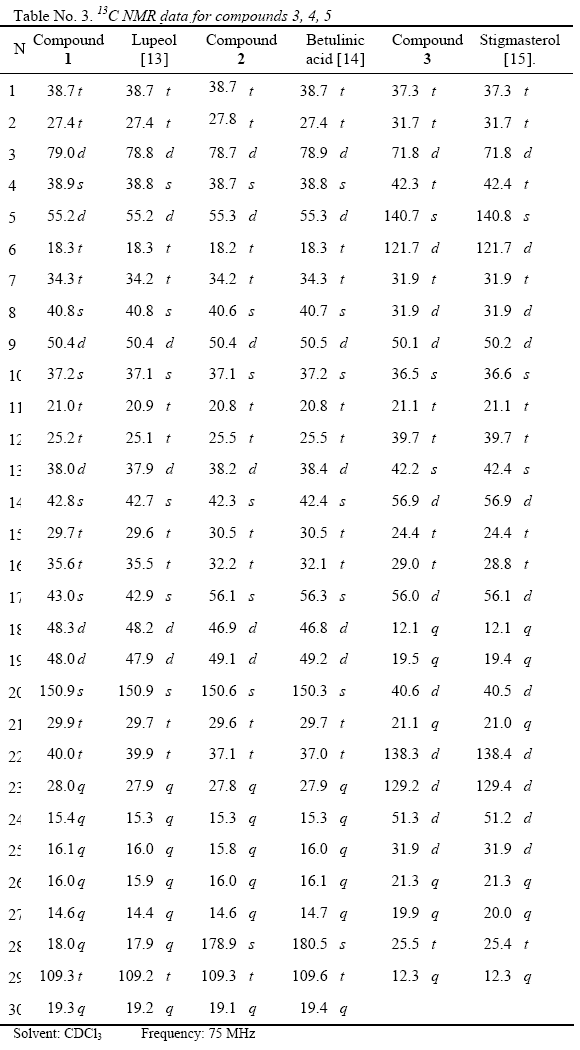
The antibacterial activity for dichloromethane extract and pure compounds was evaluated against Staphylococcus aureus (Table No. 4). The results show that the compound 4 showed some bacteriostatic activity against S. aureus.
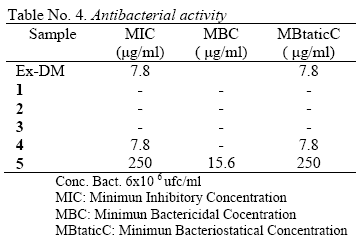
In addition, in a previous study [16] the stem bark ethanolic extract of Caesalpinia pluviosa D.C. showed activity on Chloroquine-resistant D2 strain of P. falciparum (IC50 15 μg:ml against F32 strain and IC50 8.3 μg:ml against D2 strain).
In our study the dichloromethane fraction belonged of EtOH extract and pure compounds were tested in the haem polymerization inhibitory activity HPIA assay, a test used to follow the antimalarial activity [17]. Table No. 5 shows interesting RESULTS in the crude extract and compound 5.
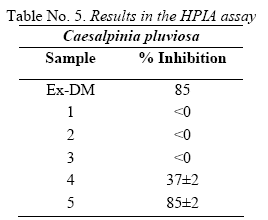
Finally based on the HPIA results the dichloromethane extract and compound 5 were tested against Plasmodium falciparum in vitro. Unfortunately the results show that the compound 5 is inactive as well as the extract. (Table No. 6)

EXPERIMENTAL
The melting points (uncorrected) were recorded on a Sanyo Gallenkamp Melting Point Apparatus. Mass spectra (HREIMS) were measured in a Waters Micromass Q-TOF apparatus. 1H and 13C NMR spectra were recorded with a Varian 300 and two-dimensional experiments were done in a Bruker 500 using as solvents CDCl3 and MD3OD; chemical shifts are reported in δ units (ppm) and coupling constants (J) in Hz. Sephadex LH-20 was used for gel filtration; Silica gel (E.M. Merck,70-230 mesh) and silica gel G-60 (E.M. Merck) were used for Chromatography Column (CC) and Vacuum Liquid Chromatography (VLC), respectively, while aluminum plates impregnated with silica gel 60 F254 (E.M. Merck) were used for analytical (0.25 mm) Thin Layer Chromatography (TLC) analyses. Spots on chromatograms were detected under UV light (254 and 365 nm) and by spraying the plates with 10% H2SO4, followed by heating.
Plant material The stem bark of Caesalpinia pluviosa D.C. was collected in September 1998 at San Buenaventura (North of La Paz, Bolivia) and identified by Lic. Lia de Michel, a botanist of the Bolivian National Herbarium (La Paz, Bolivia) where a voucher specimen is kept.
Extraction and Isolation. The dry and ground plant material (1667 g) was first extracted with 3 L of petroleum ether for 72 h at room temperature, the solution was filtered off and evaporated to yield the petroleum ether extract. The solid residue was macerated for 72 hours with 3 L ethanol, which after filtering and evaporation of the solvent gave the ethanolic extract. Finally, the ethanolic extract was extracted with 150 mL of a mixture (CH2Cl2:MeOH 9:1) this process was done for 4 times giving the CH2Cl2 extract. The petroleum ether extract (6,7 g) was subjected to VLC on silica gel, eluting with increasing amounts of CH2Cl2 in petroleum ether, followed by increased amounts of MeOH in CH2Cl2 finalizing with MeOH, to give nine main fractions. Fractions 3, 4 and 5 where submitted to other chromatography techniques followed by recrystallization with MeOH giving the compounds 1 (22.3 mg), 2 (17.9 mg) and 3 (37.2 mg). The CH2Cl2 extract was also submitted to a chromatographic analysis by VLC on silica gel followed by gel filtration on Sephadex LH-20 (CH2Cl2:MeOH 50% as eluent) giving two compounds in pure form, compound 4 (20 mg) and compound 5 (45 mg).
Compound 1 (Ethyl galleate) White crystals of mp. 213-215ºC, 1H and 13 C NMR see Table No. 1.
Compound 2 (Rhuschalcone VI) Amorphous yellow solid, mp 184-186°C, 1H and 13 C NMR see Table No. 2. HREIMS m/z 511.1342, calc. for C30H22O9+H, 511.1387.
Compound 3 (Lupeol) White crystals of mp 214-216°C, 1H NMR (CDCl3, 500 MHz) δ 4.57 d & 4.69 d (H-29A and H-29B); 3.19 dd (H-3); 2.35 ddd (H-19); 1.89 m (H-13); 1.68 s (H-30); 1.03 s (H-26); 0.97 s (H-23); 0.94 s (H-27); 0.83 s (H-25); 0.79 s (H-24); 0.76 s (H-28) and 0.68 t (H-5). C NMR see Table No. 3. 13
Compound 4 (Betulinic acid) White crystals of mp. 316-318ºC, 1H NMR (CDCl3, 500 MHz) δ 3.17 dd (H-3); 3.01 m (H-19); 0.94 s (H-23); 0.75 s (H-24); 0.85 s (H-25); 0.96 s (H-26); 1.00 s (H-27); 4.73 d (H-29A); 4.60 d (H-29B) and 1.69 s (H-30). C NMR see Table No. 3. 13
Compound 5 (Stigmasterol) White crystals of mp. 165-167ºC, 1H NMR (CDCl3, 500 MHz) δ 3.52 m (H-3); 5.35 d (H-6); 0.67 s (H-18); 1.00 s (H-19); 0.92 d (H-21); 5.15 m (H-22); 5.01 m (H-23); 1.47 m (H-25); 0.86 d (H-26); 0.79 d (H-27) and 0.84 d (H-29). 13 C NMR see Table No. 3.
Parasites
For the antimalarial in vitro evaluation, two strains of Plasmodium falciparum, F32 (sensible to chloroquine) and D2 (resistant to chloroquine), were used.
Microorganisms
The antibacterial activity was tested against Staphylococcus aureus (ATCC-25923/6538).
Biological tests
Methodologies employed for in vitro assays against protozoa are given in full details in a previous paper [16]. The protocol for HPIA test is described in [17]. The bacterial assays was done by dilution and the protocol is described in Gimenez et al., 1996 [18].
Minimal Inhibitory Concentration (MIC)
The MIC was determined by a microdilution technique using the Mueller Hinton (MHB-DIFCO) broth. The dilutions were prepared from a solution of 2 mg/ml where we added a bacterial population of 6x106 ufc/ml of each microorganism, placing in the microplate controls of bacterial growth (solvent and antibiotic). The plates were incubates at 37 °C for16-18 hrs, after this period the plates was examined visually. The MIC is considered the lowest concentration of the sample that prevents visible growth.
Minimal Bactericidal Concentration (MBC) and Minimal Bacteriostatic Concentration (MbtaticaC) were determined by sub-culturing the negative samples of the previous technique. Since the bactericidal substances not always sterilize totally a bacterial population, the minimal concentration of the bacteriological agent that allows surviving less than 0.1% of original inocule is denominates Minimal Bactericidal Concentration (MBC). MBstaticC is defined as the lowest concentration that avoid the grow of the bacteria without sterilize the bacterial population [18].
ACKNOWLEDGEMENTS
The authors are gratefully acknowledged to the Swedish Agency for International Development Cooperation (SIDA/Sarec) for the financial support of phytochemical studies; FONAMA (Fondo Nacional para el Medio Ambiente) for the financial support of the field trip and biological assays; Barcelona University and Lund University for the NMR spectra; IBBA (Instituto Boliviano de Biología de la Altura) for the antibacterial assays; IIFB (Instituto de Investigaciones Químicas) for the antibacterial assays; LPB (Herbario Nacional de Bolivia) for the identification of plant material and IRD (Francoise Institute of Research for the Development) for the HPIA evaluation and recollection of plant material.
REFERENCES
[1] Killeen, T., Garcia, E. and Beck, S., Guía de árboles de Bolivia (1993), 395. [ Links ]
[2] Bourdy G., La Paz: FONAMA 2000. [ Links ]
[3] McPherson, D. D., Che, C.-T., Cordell G. A., Soejarto D. D., Pezzuto J. M. and Fong H. H. S., Phytochemistry (1986), 25, 167. [ Links ]
[4] Kitagawa, I., Simanjuntak, P., Watano, T., Shibuya, H., Fujii, S.,Yamagata, Y., and Kobayashi, M., Chem. Pharm. Bull (1994), 42, 1798. [ Links ]
[5] Roach J. S., McLean S., Reynolds W. F. and Tinto W. F., J. Nat. Prod. (2003), 66, 1378-1381. [ Links ]
[6] Awale, S., Linn, T. Z., Tezuka, Y., Kalauni, S. K., Hari, B. A., Attamimi, F., Ueda, J. Y., and Kadota, S., Chem. Pharm. Bull (2006), 54(2) 213. [ Links ]
[7] Namikoshi, M., Nakata, H., and Saitoh, T., Phytochemistry (1987), 26, 1831. [ Links ]
[8] Srinivas, K. V. N. S., Rao, Y. K., Mahender, I., Biswanath, D.,. Rama Krishna, K. V. S., Hara Kishore, K., and. Murty, U. S. N., Phytochemistry (2003), 63, 789. [ Links ]
[9] Bahia, M. V., Dos Santos, J. B., Juceni, P. D., David, J. M., Journal of the Brazilian Chemical Society (2005), 16, 1402. [ Links ]
[10] Awasth, K. K., Kumar, A., Misra, K., Phytochemistry (1980), 19, 1995. [ Links ]
[11] Geiger, H. In The Flavonoids, Harbone, J. B., Ed., Chapman & Hall: London, (1994), 95.
[12] Mdee, L. K., Yeboah, S. O. and Abegaz, B. M., J. Nat. Prod. (2003), 66, 599. [ Links ]
[13] Reynolds, W. F., MacLean, S., Poplawski, J., Enriquez, R. G., Escobar, L., Leon, I., Tetrahedron (1986) 42, 3419 [ Links ]
[14] Siddiqui, S., Hafeez, F., Begum, S. and Siddiqui, B. S. J. Nat. Prod. (1988), 51, 229. [ Links ]
[15] Ito, A., Yasumoto, K., Kasai, R. and Yamasaki, K., Phytochemistry (1994), 36, 1465. [ Links ]
[16] Baelmans, R., Deharo, E., Bourdy, G., Muñoz, V., Quenevo, C., Sauvain, M., Ginsburg, H., Journal of Ethnopharmacology (2000), 73, 271. [ Links ]
[17]Baelmans, R., Deharo, E., Muñoz, V., Sauvain, M. and Ginsburg, H., Experimental Parasitology (1994), 96, (4), 243. [ Links ]
[18] Gimenez, A., Balderrama, L., Morales, L., Bravo, J., Muñoz, V., Ruiz, E., Balanza, E., Garcia, E., Quintana, G., Vargas, L., Arrazola, Z., Saravia, E., Lopez, A., Suarez, E., Sauvain, M., Deharo, E.and Bergeron, S.; Revista Boliviana de Quimica (1996), 35. [ Links ]














